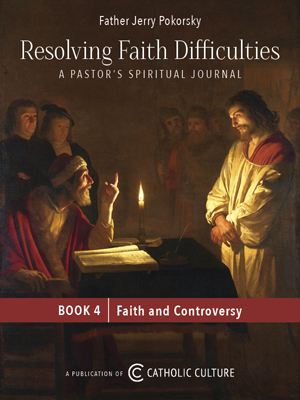And the Light Shone in the Darkness
by Andrea Monda
For Inside the Vatican, Andrea Monda interviewed Padre Pio 's best known biographer, Father Luigi Peroni.
Father Peroni, in your recent biography you recount that when one of Padre Pio's closest spiritual followers, Eligio D'Antonio, told his master: "Father, I wish to become a saint," Padre Pio replied: "A terrible profession, my Son." Besides the friar's quick sense of humor, what else does this tell us of Padre Pio?
Father Luigi Peroni: I often quote that remark to illustrate the difficulties, misunderstandings and hostility that Padre Pio encountered during his lifetime. He suffered a true calvary of persecution during the entire period of his ministry at San Giovanni Rotondo.
What could explain such a persecution? And who were his persecutors?
Peroni: Since harassment of Padre Pio lasted such a long time, the motives, perpetrators and methods were many and diverse. At the beginning, it was the local Church which showed itself most hostile to the Capuchin friar. The diocesan hierarchy at different times attempted to banish him, to reduce him to silence, and to discredit him in every way.
Was the Church in Rome also opposed to Padre Pio?
Peroni: No. From Rome Padre Pio received contradictory signals. In many circles, particularly those closest to the reigning Popes, he enjoyed esteem and respect. On the other hand, the Holy Office was less well-disposed. In my opinion, Rome was lax in disproving the absurd calumnies leveled against Padre Pio by his enemies in "faraway" Apulia (the south of Italy, where Padre Pio's monastery was located). Often accusations were credited without listening to Padre Pio's defenders.
What were the principal accusations against Padre Pio?
Peroni: From the time that Padre Pio conceived the idea for his hospital, the House for Relief of Suffering, he was criticized for his attitude towards women. With the realization of the project, that is from the 1950's onwards, he was accused of the alleged misuse of funds. In fact, that charge was a cover-up for avarice in some parts of the hierarchy, when huge contributions in money and materials came pouring in for the hospital from all parts of the world. To the great sorrow of Padre Pio, during those years he was attacked for infractions against all three of his monastic vows: poverty, chastity and obedience.
Why disobedience?
Peroni: The most diverse and ridiculous pretexts were found: for example, the length of the Masses celebrated by Padre Pio. We all know to what extent Padre Pio focused his spiritual attention on celebration of the Mass. At one point he was cautioned to "follow the common usage of good priests," that is, not to exceed 30-35 minutes.
In 1920, Padre Pio had his famous meeting with another well-respected Franciscan, Father Agostino Gemelli (founder of Rome's leading hospital). Later Father Gemelli was extremely critical of Padre Pio. Why?
Peroni: In part it was because they came from two very different cultures. Father Gemelli was from a more "positivist," or scientific background; his motive for visiting San Giovanni Rotondo was to authenticate Padre Pio's stigmata. In fact, he was prejudiced against Padre Pio's veracity from the beginning.
Father Gemelli had already written much on the subject of the stigmata. He believed that all stigmata were "psychological" rather than supernatural phenomena, with the unique exception of those of St. Francis himself, and perhaps St. Catherine of Siena.
Because of his intransigent position, Father Gemelli had some problems with the Church. He was blamed, for instance, for the slow pace of Gemma Galgani's beatification process.
What did Father Gemelli conclude concerning Padre Pio's stigmata?
Peroni: The truth is that Father Gemelli never saw Padre Pio's stigmata. Padre Pio requested written authorization to show Father Gemelli his signs; he had been instructed to do so by his superiors — and he was an obedient monk. Father Gemelli had no written permission, but kept insisting, relying on his charisma and reputation. He found his equal in Padre Pio, however, who was never impressed by position or fame, and dismissed him quite brusquely.
The esteemed Franciscan Father must have felt quite insulted, and from that time on he was Padre Pio's implacable critic. Gemelli was not always truthful in respect to his meeting with Padre Pio. He claimed falsely, for instance, that he had seen the stigmata and had observed their non-supernatural origin.
Unfortunately, Father Gemelli's evaluation of Padre Pio had a negative influence on the opinion of the times. Harassment of the Capuchin friar increased to the point that he was suspended for a few years from his spiritual ministry (except for private Mass).
Perhaps the greatest obstacle to Padre Pio's beatification was the so-called "Maccari dossier," a series of allegations collected by the Apostolic Visitor, Msgr. Carlo Macari, in the early 1960's. The most serious of these focused, once again, on the question of Padre Pio's "immorality." Please comment.
Peroni: Unfortunately Maccari listened to the voices raising charges against Padre Pio, from whatsoever source (village gossip, the outbursts of envious fellow monks), without giving equal hearing to the countless witnesses to his purity and saintliness.
Evil rumors were spread by certain village women, jealous of what they perceived as preferential treatment by Padre Pio of others. Those rancorous villagers told scurrilous stories to harm their "rivals," without concern for the harm done to Padre Pio. The unhappy result was a besmirching of Padre Pio's immaculate conduct.
How would you summarize Padre Pio's 50-year persecution?
Peroni: As the saying goes: "The light shone in the darkness, but the darkness welcomed it not" (John 1:5). • © Inside the Vatican, Martin de Porres Lay Dominican Community, 3050 Gap Knob Road, New Hope, KY 40052, 800-789-9494.
This item 1019 digitally provided courtesy of CatholicCulture.org







